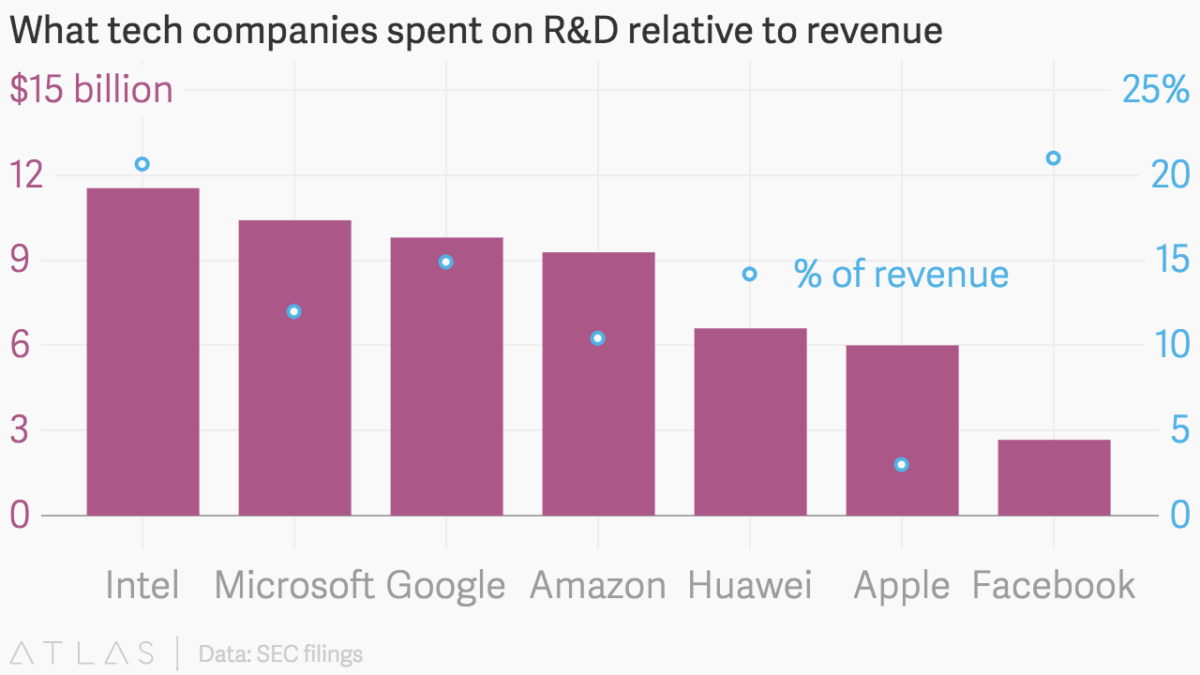When you purchase a SAAS solution, or any software for that matter, do you ever wonder whether it’s worth it? Sure, you get some benefits from economy of scale, but once you pay your provider for profits, sales/marketing, and overhead, could you do better by going it on your own?
Part of that depends on the size of the solution. If you spend $1M/year for an Oracle or Microsoft database license, that’s a lot of money. But if you need the power they provide, no R&D team in the world is going to be able to build and maintain an SQL database solution for those dollars.
Those companies know it, and that’s why many of them have 50-90% margins. Take a look at this chart:

The primary Y-axis on the left represents revenue. The secondary Y-axis on the right represents percentage of that revenue spent on research and development.
Now look at Apple. Apple spends about 3% of revenue on R&D. No wonder it’s been able to sock away $200-billion dollars. Imagine what incredible things they could do if they invested like Google and spent 12% of its revenues on R&D.
At Accio Data, we do things differently. I’ve always believed in providing the absolute highest value possible for our customers. By combining low profit margins, efficient support, and a small, efficient sales and marketing team, we’re able to invest more than 50 cents on the dollar into R&D. That is a number that is simply unheard of and I’m extremely proud of it.
Of course, it comes with tradeoffs. Our company must grow, compete, and win market share from our competitors. Analyze pretty much any industry and it’s not always the company with the best product that wins. Sometimes it’s the company with the best sales and marketing team.
So how do we do it? By forming a community that does the job for us.
When you, our clients, band together to beat the Sterlings and HireRights of the world, you strengthen your technology provider (Accio).
When you, our clients, spread the word about how Accio helps you outcompete, helps you dramatically increase margins, and lets you spend more on sales, you help us win business. Doing such an incredible job with the technology and support that you do the selling for us is an essential component of our being able to provide you with more value than you can get anywhere else.
Being the very best and depending on our customers to sell for us is a strategy that works for us because there are some very special things going for us: an incredibly loyal customer base, a small number of competitors, and a small enough community of CRAs that everyone hears your stories about us.
Now Let’s Talk About How You Can Grow
You, as a CRA, are in a different position. I’ve seen outstanding CRAs apply the same methodologies as Accio and have some success. But from my observations of hundreds of clients, it works only for smaller (<$5M) CRAs and it generally results in growth of at most 20% (plus intrinsic growth) per year. Intrinsic growth is the growth experienced approximately equally by all CRAs in a given industry based on hiring growth in their industry.
So how do CRAs grow? From my observations, in the traditional way. An excellent product and excellent service helps, but every fast growing CRA I’ve ever observed has grown in direct proportion to one thing and one thing only: sales and marketing spend.
How does that spend turn into revenue? Some customers are much more effective than others, but the formula ranges from 1x sales and marketing spending to about 4x. If your return on sales and marketing is less than 1x on an annual basis, your team is not performing well and I’d recommend that you look outside your company for help. You probably also need to ask yourself some hard questions about your team’s performance and whether you need some turnover.
What does all this mean to you? First, you need to answer three questions:
- What is your intrinsic growth?
- How much money do you you spend on sales and marketing?
- What is your return on sales and marketin spending (overall growth minus intrinsic growth)?
Looking at it this way, your growth becomes pretty predictable. For example, if your current growth is $200K/year and you spend $100K on sales and marketing, then if you want to grow your revenue by $1M/year, you need to spend $500K on sales and marketing while carefully managing your team to ensure that your revenue growth multiplier stays the same or increases with your larger team.
What about technology expenditures? Accio Data’s job is to give you the absolute best technology we can possibly give you for your money. But what if you come across a deal that requires an expensive integration or feature you don’t have?
We have two major customer philosophies about this and both work equally well for the companies that employ them. Your business philosophy and the specific market segment you decide to get into will heavily influence which approach is best for you.
The KISS (Keep It Simple, Stupid) Approach
This is the most popular approach our clients take. It’s pretty simple: sell what you have. Some of our clients take this approach and grow at 1X sales and marketing expenditures and others grow at 4X. A big part of the difference is your team. A key component of a team that works best with this approach is one that quickly goes for the “no.” What does this mean? This means that your sales team must very quickly identify the needs of the customer and be prepared to walk – and walk fast – if you don’t have the technology you need to close the deal.
Going with KISS approach but having a sales team that gets two months into a complex RFP and demo process when you don’t have the features you need to win is the primary factor in a low-performing sales team. If you go with KISS, your sales team needs to evaluate and walk away fast from deals they can’t win so that they spend their time on the deals that they can win.
The Boutique Approach
Only about 5% of our customers employ the Boutique approach (we’ll build you whatever you want, no matter what it is). And here’s the fascinating part of it to me – these customers have exactly the same range of sales and marketing expenditure to revenue growth as the KISS customers.
When you get down to it, the Boutique approach also relies on rapid, early evaluation of your potential customer. But the evaluation is a different one. With this approach, the salesperson must very quickly identify the key special needs you must address to win the customer and work with Accio Data to figure out what they will cost. Also, like the KISS approach, you need to quickly make the decision to cut bait or win the client.
Key to the “cut bait quickly” decision is understanding that you must land customers large enough to pay for the cost to service them. You have to quickly evaluate the R&D expenditures you’ll need to make to win the client and the client’s value (revenue & profit) to your organization. If you have a deal in front of you that’s going to cost you $30K for a custom project to win, they’re a $300K/year account, and your business has at least a 10% margin, then the decision is simple: pay the $30K, land the client, and have an extremely sticky customer. But if you’ve got to spend $30K on R&D to land them and they’re a $50K account, learn that fact fast. Then walk away quickly and let someone else go lose money to buy that account.
So which is better: KISS or Boutique? Certainly, KISS is much more popular in this industry. Accio has many more customers who grow quickly with this approach.
Where the Boutique approach wins (and wins big) is in margins and customer retention. If you’re one of the 5% of CRA’s willing to spend heavily on R&D to acquire a customer, that customer is: (a) not going to want to leave; and (b) going to have a hard time finding another CRA who’ll do what they need. Why? Because, while only 5% of Accio CRAs are willing and able to do this, the percentage of CRAs in the overall industry who will do this is probably much lower than 5%. I’d estimate it at 1% based on empirical evidence but I don’t have hard numbers to back this up. Margins are much better specifically because customer retention is much higher.
So which wins? In Barry’s Book, it’s the company that uses both techniques equally well. Identify Boutique clients. Service them like Boutique clients. This means having a separate sales team for them, separate account reps for them, and sometimes even a separate research team.
But also identify your commodity accounts. Don’t offer commodity accounts your expensive heavy hitters. Put the sales guys on these accounts who are able to close high volumes of sales rapidly and save your best account reps for the boutique accounts who will make it worth the extra expense in higher retentions.
